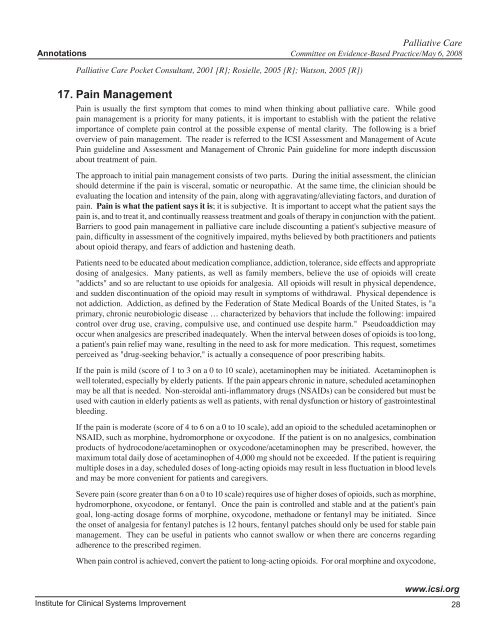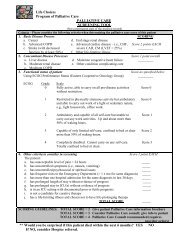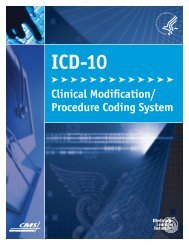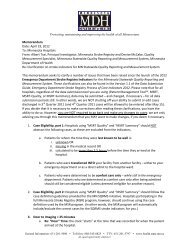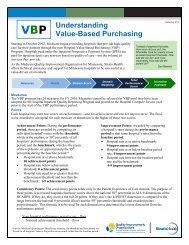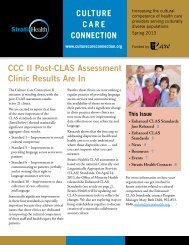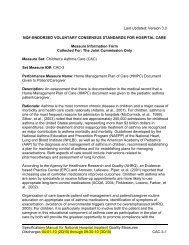Palliative Care Order Set - Stratis Health
Palliative Care Order Set - Stratis Health
Palliative Care Order Set - Stratis Health
You also want an ePaper? Increase the reach of your titles
YUMPU automatically turns print PDFs into web optimized ePapers that Google loves.
<strong>Palliative</strong> <strong>Care</strong><br />
Annotations Committee on Evidence-Based Practice/May 6, 2008<br />
<strong>Palliative</strong> <strong>Care</strong> Pocket Consultant, 2001 [R]; Rosielle, 2005 [R]; Watson, 2005 [R])<br />
17. Pain Management<br />
Pain is usually the first symptom that comes to mind when thinking about palliative care. While good<br />
pain management is a priority for many patients, it is important to establish with the patient the relative<br />
importance of complete pain control at the possible expense of mental clarity. The following is a brief<br />
overview of pain management. The reader is referred to the ICSI Assessment and Management of Acute<br />
Pain guideline and Assessment and Management of Chronic Pain guideline for more indepth discussion<br />
about treatment of pain.<br />
The approach to initial pain management consists of two parts. During the initial assessment, the clinician<br />
should determine if the pain is visceral, somatic or neuropathic. At the same time, the clinician should be<br />
evaluating the location and intensity of the pain, along with aggravating/alleviating factors, and duration of<br />
pain. Pain is what the patient says it is; it is subjective. It is important to accept what the patient says the<br />
pain is, and to treat it, and continually reassess treatment and goals of therapy in conjunction with the patient.<br />
Barriers to good pain management in palliative care include discounting a patient's subjective measure of<br />
pain, difficulty in assessment of the cognitively impaired, myths believed by both practitioners and patients<br />
about opioid therapy, and fears of addiction and hastening death.<br />
Patients need to be educated about medication compliance, addiction, tolerance, side effects and appropriate<br />
dosing of analgesics. Many patients, as well as family members, believe the use of opioids will create<br />
"addicts" and so are reluctant to use opioids for analgesia. All opioids will result in physical dependence,<br />
and sudden discontinuation of the opioid may result in symptoms of withdrawal. Physical dependence is<br />
not addiction. Addiction, as defined by the Federation of State Medical Boards of the United States, is "a<br />
primary, chronic neurobiologic disease … characterized by behaviors that include the following: impaired<br />
control over drug use, craving, compulsive use, and continued use despite harm." Pseudoaddiction may<br />
occur when analgesics are prescribed inadequately. When the interval between doses of opioids is too long,<br />
a patient's pain relief may wane, resulting in the need to ask for more medication. This request, sometimes<br />
perceived as "drug-seeking behavior," is actually a consequence of poor prescribing habits.<br />
If the pain is mild (score of 1 to 3 on a 0 to 10 scale), acetaminophen may be initiated. Acetaminophen is<br />
well tolerated, especially by elderly patients. If the pain appears chronic in nature, scheduled acetaminophen<br />
may be all that is needed. Non-steroidal anti-inflammatory drugs (NSAIDs) can be considered but must be<br />
used with caution in elderly patients as well as patients, with renal dysfunction or history of gastrointestinal<br />
bleeding.<br />
If the pain is moderate (score of 4 to 6 on a 0 to 10 scale), add an opioid to the scheduled acetaminophen or<br />
NSAID, such as morphine, hydromorphone or oxycodone. If the patient is on no analgesics, combination<br />
products of hydrocodone/acetaminophen or oxycodone/acetaminophen may be prescribed, however, the<br />
maximum total daily dose of acetaminophen of 4,000 mg should not be exceeded. If the patient is requiring<br />
multiple doses in a day, scheduled doses of long-acting opioids may result in less fluctuation in blood levels<br />
and may be more convenient for patients and caregivers.<br />
Severe pain (score greater than 6 on a 0 to 10 scale) requires use of higher doses of opioids, such as morphine,<br />
hydromorphone, oxycodone, or fentanyl. Once the pain is controlled and stable and at the patient's pain<br />
goal, long-acting dosage forms of morphine, oxycodone, methadone or fentanyl may be initiated. Since<br />
the onset of analgesia for fentanyl patches is 12 hours, fentanyl patches should only be used for stable pain<br />
management. They can be useful in patients who cannot swallow or when there are concerns regarding<br />
adherence to the prescribed regimen.<br />
When pain control is achieved, convert the patient to long-acting opioids. For oral morphine and oxycodone,<br />
www.icsi.org<br />
Institute for Clinical Systems Improvement<br />
28


